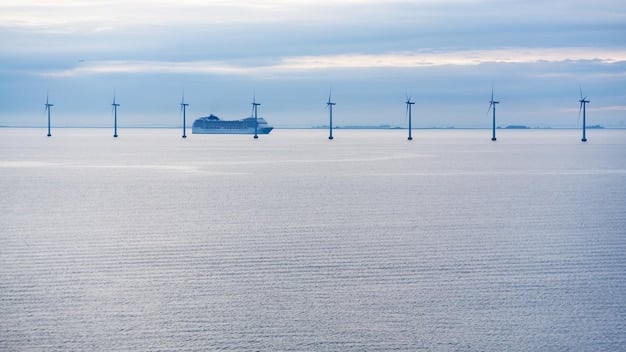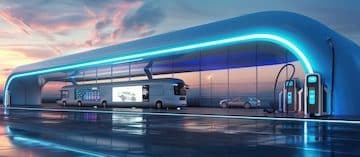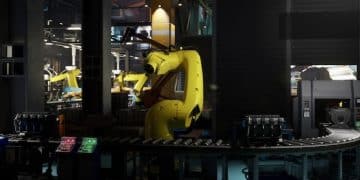US Renewable Energy Tech: Innovations Driving a Sustainable Future

Exploring the forefront of clean energy, US Renewable Energy Tech: Innovations Driving a Sustainable Future highlights groundbreaking advancements in solar, wind, and energy storage transforming America’s energy landscape towards a greener, more resilient future.
The quest for sustainable energy solutions has never been more urgent, and the United States stands at the vanguard of this global transformation. As we navigate environmental challenges and seek energy independence, understanding the landscape of US Renewable Energy Tech: Innovations Driving a Sustainable Future becomes critical. This article delves into the cutting-edge developments poised to reshape how we power our homes, industries, and transportation systems.
The Solar Revolution: Beyond Panels
Solar energy continues to be a cornerstone of renewable power, and innovations in the US are pushing its capabilities far beyond traditional rooftop panels. We are witnessing a rapid evolution in photovoltaic (PV) technology, making solar more efficient, versatile, and cost-effective than ever before.
One significant area of progress is the development of next-generation PV materials. Perovskite solar cells, for instance, are showing remarkable efficiency in laboratory settings and hold the promise of being cheaper and easier to manufacture than traditional silicon cells. While challenges remain in terms of stability and scalability, US researchers are actively pursuing these breakthroughs. Another intriguing advancement is transparent solar technology, which allows windows to generate electricity without obstructing natural light, potentially turning every building into an energy producer.
Advancements in Solar Cell Efficiency and Durability
Scientists and engineers are relentlessly pursuing higher efficiency rates for solar cells, aiming to convert more sunlight into electricity. This involves intricate material science and sophisticated manufacturing techniques. Simultaneously, there’s a strong focus on increasing the longevity and resilience of solar panels, ensuring they can withstand diverse environmental conditions for decades.
- Perovskite Technology: Emerging as a highly efficient and potentially low-cost alternative to silicon, offering promising pathways for flexible and transparent applications.
- Passivated Emitter Rear Cell (PERC): An established technology that enhances efficiency by capturing more light near the back surface of the cell.
- Bifacial Solar Panels: Capable of generating electricity from both sides, increasing overall energy output by capturing reflected sunlight.
- Integrated Photovoltaics: Solar cells designed to seamlessly blend into building materials, such as roof tiles or facade elements, offering aesthetic appeal and energy generation.
Beyond the cells themselves, innovations in solar are also found in balance-of-system components and installation methods. Smart inverters are becoming more common, optimizing energy conversion and enabling better grid integration. Automated installation techniques are reducing labor costs, making solar deployment faster and more economical, further accelerating its adoption across the country.
These diverse advancements indicate a vibrant future for solar energy in the US, moving beyond niche applications to become a pervasive and foundational element of our energy infrastructure. The continued drive for efficiency, cost reduction, and new applications ensures solar’s prominent role in a sustainable future.
Wind Power’s Ascent: Larger Turbines, Smarter Grids
Wind energy has long been a significant contributor to the US renewable portfolio, and recent innovations are solidifying its position. The trend is clear: bigger turbines, smarter operations, and strategic offshore development are boosting wind power’s capacity and reliability.
A key development is the significant increase in turbine size and height. Taller towers and longer blades allow turbines to capture stronger, more consistent winds at higher altitudes, leading to substantially greater energy generation per turbine. This scale enables fewer turbines to produce the same amount of power, reducing land footprint and visual impact in some cases.
Offshore Wind: A Game Changer for Coastal States
The vast potential of offshore wind is increasingly being realized. The US has immense offshore wind resources, particularly along the Atlantic and Pacific coasts, where consistent high winds can provide a stable and powerful energy source. Developing these resources requires robust engineering and coordinated infrastructure planning.
- Floating Wind Turbines: Essential for deeper waters, this technology allows turbines to be anchored to the seafloor via mooring lines, opening up vast new areas for offshore wind development.
- Advanced Geotechnical Surveys: Crucial for understanding seabed conditions to ensure stable and long-lasting foundations for fixed-bottom turbines.
- Grid Interconnection Solutions: Developing high-capacity underwater cables and substations to efficiently transmit power from offshore farms to onshore grids.
Furthermore, innovations in wind energy extend to predictive maintenance using AI and sensor technology. These systems monitor turbine health in real-time, anticipating potential failures and enabling proactive repairs, thereby minimizing downtime and maximizing energy production. The integration of wind farms into smart grids also ensures that this variable energy source can be effectively managed and balanced with other generation types, contributing to overall grid stability and resilience.

The progression in wind technology, from colossal onshore turbines to cutting-edge offshore projects, signals a transformative era for renewable energy. These advancements promise to harness more wind power efficiently, playing a crucial role in diversifying the US energy mix and reducing reliance on fossil fuels.
Energy Storage Solutions: The Linchpin of Renewables
The intermittency of renewable energy sources like solar and wind necessitates robust energy storage solutions. Innovations in this sector are paramount for ensuring grid stability, enabling greater renewable integration, and providing reliable power when the sun isn’t shining or the wind isn’t blowing.
Lithium-ion batteries currently dominate the energy storage landscape for grid-scale applications, benefiting from significant cost reductions and performance improvements driven by the electric vehicle industry. However, research and development in the US are actively exploring a diverse array of alternative storage technologies to meet varying needs, from short-duration grid support to long-duration seasonal storage.
Beyond Lithium-Ion: Emerging Battery Technologies
While lithium-ion remains critical, the push for safer, cheaper, and more sustainable alternatives is intense. Flow batteries, for example, offer distinct advantages for long-duration storage due to their scalability and ability to separate power and energy capacity. Solid-state batteries, still largely in the research phase for grid applications, promise higher energy density and improved safety. Zinc-based batteries are also gaining attention for their abundance and lower material costs.
- Flow Batteries: Utilizing liquid electrolytes for flexible scaling of power and energy, ideal for grid support over multiple hours.
- Solid-State Batteries: Replacing liquid electrolytes with solid ones, enhancing safety and potentially energy density.
- Zinc-Air Batteries: Employing abundant and inexpensive zinc as an electrode, offering a cost-effective storage solution.
Beyond batteries, other forms of energy storage are also evolving. Pumped-hydro storage, though geographically limited, continues to be a vital large-scale energy reserve. Thermal energy storage, which stores heat or cold, is gaining traction for industrial processes and community-level heating/cooling systems, often coupled with concentrated solar power plants.
The integration of these storage systems into intelligent grid management platforms is crucial. Advanced software and AI are optimizing charge and discharge cycles, predicting demand patterns, and enhancing grid resilience. These innovations are not just about storing energy; they’re about transforming how energy flows through our entire system, making it more flexible, efficient, and reliable.
The ongoing commitment to diverse storage technologies underscores their critical role in the future of US renewable energy. By overcoming the challenge of intermittency, these solutions unlock the full potential of renewables, enabling a truly continuous and reliable clean energy supply.
Grid Modernization: The Smart Energy Superhighway
The proliferation of renewable energy sources and distributed generation makes grid modernization an urgent imperative. The traditional unidirectional power grid is being transformed into a dynamic, two-way “smart grid” capable of managing complex energy flows, enhancing reliability, and integrating diverse technologies.
Key to this transformation is the deployment of advanced metering infrastructure (AMI), often referred to as smart meters. These devices provide real-time data on energy consumption, enabling utilities to manage demand more effectively and empowering consumers with better insights into their energy use. This granular data is foundational for demand-response programs, where consumers adjust their energy consumption in response to price signals or grid needs.
Digitalizing the Grid: AI, Machine Learning, and Cybersecurity
Artificial intelligence (AI) and machine learning (ML) are becoming indispensable tools in grid management. These technologies analyze vast datasets from sensors, meters, and weather forecasts to predict energy generation and demand with unprecedented accuracy. This predictive capability allows grid operators to optimize power dispatch, minimize waste, and prevent outages.
- Predictive Analytics: AI models forecast energy supply from renewables and consumer demand, optimizing grid operations.
- Automated Grid Restoration: Self-healing grid technologies powered by AI can quickly detect and isolate faults, rerouting power to minimize outage duration.
- Cybersecurity Enhancements: Robust security protocols and AI-driven threat detection systems are critical to protect the digitalized grid from cyberattacks.
Furthermore, cybersecurity is a paramount concern for a smart grid. As more connected devices and digital controls are integrated, the attack surface expands. US efforts are heavily focused on developing resilient, secure grid architectures that can detect, withstand, and rapidly recover from cyber threats, ensuring the continuous and safe operation of critical energy infrastructure.
The modernization also involves creating local microgrids capable of operating independently from the main grid during emergencies. These localized energy systems, often combining renewables, storage, and conventional generation, enhance community resilience and provide critical power during disasters.
Ultimately, a modernized, smart grid acts as the central nervous system for the sustainable energy future. Its ability to intelligently manage and integrate diverse energy sources ensures not only reliability but also efficiency, paving the way for a more resilient and sustainable energy landscape across the US.
Policy and Investment: Fueling the Innovation Engine
While technological breakthroughs are essential, supportive policies and strategic investments are equally critical in driving the adoption and scaling of US renewable energy technologies. Government initiatives, private sector funding, and international collaborations play pivotal roles in accelerating the transition to a sustainable future.
The US government has implemented a range of policies aimed at incentivizing renewable energy development. Tax credits, grants, and loan programs help de-risk investments in new technologies and accelerate project deployment. These financial incentives lower the upfront costs for developers and consumers, making renewable energy more competitive with conventional sources.
Public-Private Partnerships and Research Funding
A synergistic approach between public and private sectors is crucial for translational research and scaling innovative technologies. Government agencies like the Department of Energy (DOE) fund foundational research, while private companies invest in commercialization and large-scale deployment. This collaboration ensures a robust pipeline from laboratory discovery to market readiness.
- DOE Research Programs: Funding academic institutions and national labs for cutting-edge basic and applied research in renewables and storage.
- Federal Tax Credits (e.g., ITC, PTC): Providing significant financial incentives for solar and wind projects, lowering their cost and increasing their attractiveness to investors.
- SBIR/STTR Grants: Small Business Innovation Research (SBIR) and Small Business Technology Transfer (STTR) programs supporting small businesses in developing innovative technologies.
Beyond direct funding, regulatory frameworks also play a significant role. State-level Renewable Portfolio Standards (RPS) mandate a certain percentage of electricity generation come from renewable sources, creating a sustained market demand. Streamlined permitting processes and interconnection standards also reduce barriers to project development, making it easier and faster to bring new renewable capacity online.
Venture capital and private equity firms are increasingly channeling investments into clean energy startups and established companies, recognizing the immense growth potential in this sector. This flow of private capital is vital for bridging the gap between research and commercial deployment, bringing innovative solutions to market more quickly.
The concerted efforts in policy and investment are creating a fertile ground for renewable energy innovation to flourish in the US. This supportive ecosystem is not only driving domestic growth but also positioning the US as a leader in global energy transition efforts, showcasing how strategic support can unlock immense potential.
Environmental and Economic Impacts: A Dual Dividend
The shift towards renewable energy in the US is not merely a technological transition; it represents a fundamental change with profound environmental benefits and significant economic opportunities. The dual dividend of cleaner air and robust economic growth underpins the acceleration of renewable energy adoption.
Environmentally, the most immediate and impactful benefit is the reduction of greenhouse gas emissions. By replacing fossil fuels with solar, wind, and other clean sources, the US significantly lowers its carbon footprint, directly contributing to climate change mitigation. This transition also leads to improved air quality, reducing pollutants that cause respiratory illnesses and other health problems, particularly in urban areas.
Job Creation and Energy Independence
Economically, the renewable energy sector is a powerful engine for job creation. From manufacturing and installation to operations and maintenance, the clean energy industry supports a diverse range of high-paying jobs across various skill levels. This growth contributes to local economies and offers new career pathways for the workforce.
- Manufacturing Jobs: Producing solar panels, wind turbine components, and battery cells domestically.
- Installation and Construction: Building new renewable energy projects and related infrastructure.
- Operations and Maintenance: Long-term jobs required to keep renewable energy facilities running efficiently.
- Research and Development: High-skilled positions in laboratories and universities, driving future innovations.
Furthermore, increased reliance on domestic renewable energy sources enhances energy independence and security. By reducing dependence on imported fossil fuels, the US becomes less susceptible to geopolitical instabilities and volatile global energy markets. This self-sufficiency provides greater stability for consumers and industries alike.
The economic benefits extend to consumers as well. While initial investments in renewables can be significant, the long-term operational costs are minimal, often leading to more stable and predictable electricity prices compared to fossil fuel-based generation. This can result in significant savings for households and businesses over the lifespan of renewable energy systems.
The environmental and economic advantages of renewable energy together paint a compelling picture of a sustainable future. The continuous innovation in US renewable energy technologies directly contributes to a healthier planet and a more prosperous economy, making the transition not just an environmental necessity but also an economic imperative for nationwide benefit.
| Key Area | Brief Description |
|---|---|
| ☀️ Solar Innovations | Advancements in perovskite, transparent solar, and bifacial panels boosting efficiency and versatility. |
| 🌬️ Wind Power Growth | Larger turbines and significant offshore wind development, leveraging advanced technologies. |
| 🔋 Energy Storage | Crucial for grid stability, exploring beyond lithium-ion with flow and solid-state batteries. |
| 💡 Smart Grid & Policy | Modernizing infrastructure with AI, ML, and supportive policies to integrate diverse energy sources. |
Frequently Asked Questions about US Renewable Energy Tech
▼
The growth is primarily driven by decreasing technology costs, supportive government policies and tax incentives, increasing public and corporate demand for clean energy, and concerns about climate change. Technological advancements, particularly in solar and wind efficiency, also play a crucial role in making renewables more competitive.
▼
Energy storage is crucial for addressing the intermittency of renewable sources like solar and wind. By storing excess energy and releasing it when needed, storage systems ensure a more reliable and stable power supply, enabling higher penetration of renewables into the grid and reducing reliance on fossil fuel “peaker” plants.
▼
Offshore wind has immense potential due to stronger and more consistent wind speeds compared to onshore. It offers a significant pathway to large-scale renewable energy generation, especially for coastal states with high population densities. Innovations in floating turbine technology are expanding the viable areas for deployment, unlocking vast untapped resources.
▼
Yes, significant economic benefits exist, including job creation across manufacturing, installation, operations, and research sectors. It also enhances energy independence, reduces exposure to volatile global fuel markets, and can lead to more stable electricity prices for consumers over the long term. Local economic development is also a substantial driver.
▼
Key challenges include grid modernization to handle distributed and intermittent power, the need for long-duration energy storage, permitting complexities for large-scale projects, supply chain vulnerabilities, and ensuring equitable access to clean energy benefits. Continued innovation and policy support are addressing these hurdles.

Conclusion
The journey towards a sustainable energy future in the United States is propelled by relentless innovation across various renewable energy technologies. From the evolving landscape of solar and the immense potential of wind power to the critical advancements in energy storage and the strategic modernization of our grid, each element intertwines to forge a more resilient and environmentally conscious energy system. Coupled with supportive policies and vital investments, these technological strides are not only mitigating climate change but also fostering robust economic growth and enhancing national energy security. The ongoing commitment to innovation ensures that the US remains at the forefront of the global energy transition, proving that a greener, cleaner, and brighter future is not just aspirational, but an achievable reality through sustained development and strategic implementation of renewable energy solutions.





